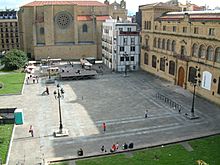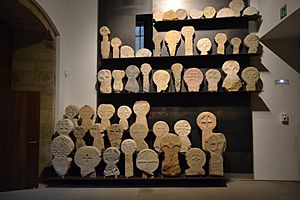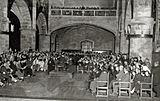San Telmo Museoa facts for kids

Setting of San Telmo Museoa at the foot of the hill Urgull by the ocean
|
|
| Lua error in Module:Location_map at line 420: attempt to index field 'wikibase' (a nil value). | |
| Established | 5 October 1902 |
|---|---|
| Location | Zuloaga plaza, 1 20003 San Sebastián Basque Country, Spain |
| Type | Art museum History museum Ethnography Photography Archeology |
| Collection size | 26,000 |
| Visitors | 261.880 (2015) |
| Owner | City of Donostia-San Sebastián |
The San Telmo Museoa (also known as the San Telmo Museum or STM) is a museum located in Donostia-San Sebastián, a city in the Basque Country region of Spain. It focuses on both old and new Basque culture, art, and history, looking at them in a wider European and global way. The museum moved to its current home in 1932. This spot is in Zuloaga plaza, in the old part of the city, right at the bottom of Urgull hill. The museum building used to be a Dominican monastery, and a new, modern part was added in the 21st century.
San Telmo is more than just a museum; it's also a place to share knowledge and new ideas. It helps us understand the present and build the future by connecting with the past and our roots. In 2011, the museum had a big renovation. A new section was added to the old monastery, and the whole place was updated to fit its new goal: to be a museum about Basque society and its people. In 2013, the museum received a special award in the European Museum of the Year contest.
Contents
Museum History
The Basque Society of Friends of the Country wanted to open a museum in Donostia-San Sebastián. This idea came after successful art shows in the city in the late 1800s. So, the society officially asked the city council to create a Municipal Museum.
The San Telmo Museoa first opened its doors in 1902. It was located on the corner of Andia and Garibai streets. However, the museum quickly became too small for all its collections. Because of this, a new location was chosen in 1905. This new building was shared with the Municipal Library and the School of Arts and Professions.
In 1932, the museum moved again to its current home, the San Telmo monastery. The city bought and prepared the monastery for the museum. For the grand opening in its new location, a concert was held. The famous composer Manuel de Falla conducted the music in the church. The church was decorated with amazing paintings by the Catalan artist Josep Maria Sert. His murals also decorate the walls of the Council Chamber at the Palace of Nations in Geneva.
For many years, the museum focused on ethnography, which is the study of cultures. But in 2009, the museum began a big update with new construction. After two years of changes, the museum reopened in 2011. It now had modern facilities and a new focus as a museum of Basque society and its citizens. This museum is the oldest in the Basque Country. It brings its rich history and ideas into the 21st century. It also acts as a main center for other local museums across Gipuzkoa. The museum received a special award in the 2013 museum contest.
Building the Museum
Original Monastery Building
The main museum building is very old, dating back to the 1500s. It was first built to be a Dominican convent. It includes a church, a cloister (a covered walkway around a courtyard), and a tower. Wealthy families from the area helped pay for the monastery. These included Alonso de Idiaquez, who was a secretary for Emperor Charles V, and his wife Gracia de Olazabal. The main construction work started in 1544 and finished in 1562.
The building's style is a mix of Gothic and Renaissance, sometimes called "Elizabethan" style. It has a Gothic base, but its upper parts show Renaissance features. The cloister is special because of its unusual spot right at the start of the church. This was because of how close it was to the hill.
In 1813, at the end of the Peninsular War, San Sebastián was attacked and badly damaged by British and Portuguese troops. The convent also suffered a lot of damage. In 1836, the Spanish leader Juan Álvarez Mendizábal ordered that church properties be taken by the government. This led to the Dominican friars leaving, and the convent became army barracks.
By 1913, the monastery was in poor condition. The tower was then named a National Monument to protect it. The city wanted to buy the whole complex, which it did in 1929. It reopened in 1932 as the city's ethnographic museum. A Renaissance-style front was added, which you can still see today.
2011 Modern Makeover
In 2007, the museum closed for a big renovation to create "a new story" for its exhibits. After four years, the museum reopened on April 19, 2011. The project cost about 28.5 million euros. Important people attended the opening, including the Basque president Patxi Lopez.
The large renovation and expansion project was designed by architects Fuensanta Nieto and Enrique Sobejano. They added a modern extension into the lower part of Urgull hill. This new space allows for more cultural and commercial activities. It also makes it easier for visitors and for moving collections. The new two buildings replaced an older structure from the mid-20th century that didn't fit the original design. This older building was removed when the work started. The main entrance now leads directly to the old buildings and connects to new areas. These new areas include cloakrooms, a shop, an events room, a cafeteria, and other spaces a modern museum needs.
To make the new buildings blend in, their outside walls have holes cut into 3,000 melted aluminum panels. These holes look like natural erosion on rocks, and plants grow out of them. This creates a green layer that changes with the seasons. The design helps the building fit between the city and the natural hill. The holes also let natural light into the museum during the day. At night, they allow artificial light to shine out. Leopoldo Ferran and Agustina Otero created this unique design.
Most of the museum's permanent exhibits are still in the church and rooms of the old building. However, the new extension also holds parts of the permanent exhibition. Together, these areas cover about 3,000 square meters, including the church. The temporary exhibition area is about 1,000 square meters. It is spread across the new building and the convent chapels. The new buildings also have an events room that can hold 300 people, labs, workshops, and a shop. The ground floor has a restaurant that tries out new food ideas.
During the renovation of the convent, old Mannerist paintings were found in the church's apse (the curved part behind the altar). These paintings were studied by Pedro Echeverria from the University of the Basque Country. They are connected to important painters of that time. These paintings make the church even more interesting, along with the famous large paintings by Josep Maria Sert. When it reopened in 2011, the goal of the new museum was not just to be a museum. It also aimed to become a cultural center, like the Musée du Quai Branly in Paris or the V&A Museum in London. The San Telmo building is a special place for its city and people, and it's also known around the world for its architecture.
Museum Collections
The museum's exhibits are organized into different themes. These themes help show the idea of a museum for society with a focus on its citizens. The items on display in the permanent exhibition are very diverse. They range from old gravestones in the "Signs of Spirituality" section to later items. These include a sword believed to belong to Muhammad XII of Granada (also known as "Boabdil") and Ignatius of Loyola's spiritual writings. There are also modern objects like bicycles, a Seat 600 car, and historic football jerseys from Real Sociedad and Athletic Club Bilbao. These are shown in the "Awakening of Modernity" section.
The strong connection of the Basques to the ocean, whale hunting, iron mining, and manufacturing are also important parts of the museum. Religion and art are also key themes. The museum has a large collection of paintings and sculptures. About 200 artworks are on display. These include pieces by famous artists like El Greco, Sorolla, and Ignacio Zuloaga. They are shown in two different ways.
Inside the church, a video called "Challenges for Our Society" is shown. This video helps visitors understand the main challenges for Basque society in the future. These challenges include sustainability, interculturality (different cultures living together), equality, Europe, and Human Rights.
Temporary Exhibitions
Besides its permanent collection, the museum also hosts temporary exhibitions. These are mostly held in the newer parts of the building. For example, starting in June 2016, the museum featured the "Peace Treaties in Art" exhibition. This was part of the city's role as European Capital of Culture. The museum covers many different topics in its temporary shows. These topics fit its role as a museum of society and citizenship, connecting the past and future by looking at today's challenges.
Not long after the museum reopened, in autumn 2011, a temporary exhibition about Federico Fellini took place. It showed more than 400 items. These included photos, drawings, magazines, cartoons, interviews, and film clips. Some of these were unknown before. The exhibition helped people learn about this amazing film director.
Later, from January to October 2015, the museum hosted the "Pasolini Roma" exhibition. This show featured the literary and film work of Pier Paolo Pasolini. It also included details about the life of this Italian poet, film director, and thinker. The exhibition at San Telmo was one stop on its journey across Europe. It also showed in Barcelona, Berlin, Paris, and Rome. The exhibition was paired with related film screenings, a discussion with filmmakers, and a special Pasolini evening.
After the Pasolini exhibit ended, another one opened in January 2016. This one was called "Gaur konstelazioak." It focused on the important Basque art group Gaur. This group was formed in the mid-1960s as an artistic response to Franco's dictatorship. They also defended the Basque identity, which was being suppressed. The exhibition showed works by famous artists who were part of the group. These included Jorge Oteiza, Jose Luis Zumeta, and Eduardo Chillida, as well as José Antonio Sistiaga and Nestor Basterretxea.
Fifty years had passed since this art group formed around the Galeria Barandiaran. So, the exhibition was a way to honor Dionisio Barandiaran. He was a local business owner and generous person who helped start the Gaur project. The exhibition was presented along with Kairos, a modern art section. This section created a conversation and connection between Gaur and today's artists.
Images for kids
- San Telmo views
See also
 In Spanish: Museo San Telmo para niños
In Spanish: Museo San Telmo para niños
























